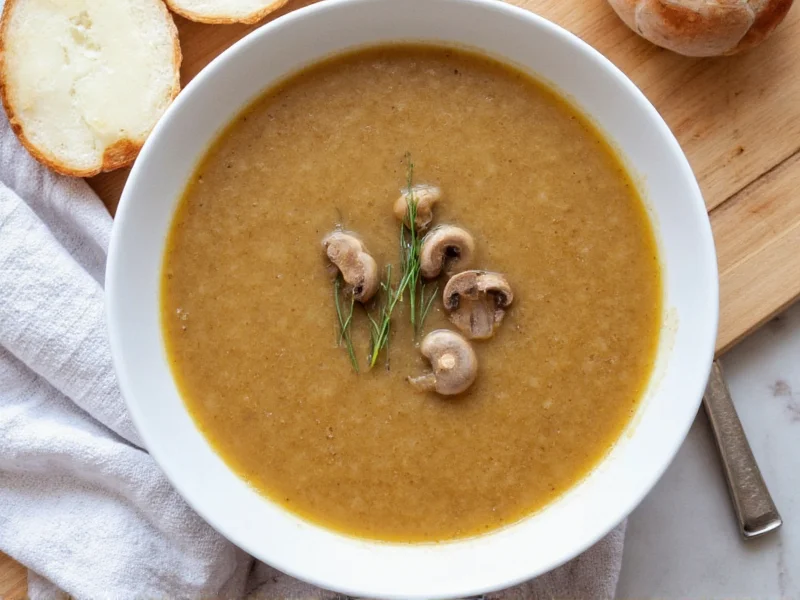The Perfect Harmony of Barley and Mushrooms
Barley mushroom soup represents one of culinary history's most successful pairings. The nutty, chewy texture of barley complements the earthy depth of mushrooms perfectly. Unlike many quick-fix recipes, authentic barley mushroom soup requires proper technique to maximize flavor development while maintaining ideal texture in both key ingredients.
Essential Ingredients and Their Roles
Creating exceptional barley mushroom soup starts with understanding each component's purpose. The magic happens when these elements work together:
| Ingredient | Function | Best Varieties |
|---|---|---|
| Pearl barley | Provides chewy texture and thickens broth naturally | Hulled barley for more nutrition, pearl barley for quicker cooking |
| Mushrooms | Creates rich umami base and meaty texture | Cremini for depth, shiitake for intensity, porcini for earthiness |
| Aromatics | Builds flavor foundation | Yellow onion, carrots, celery, garlic |
| Acid component | Balances richness and brightens flavors | Fresh thyme, bay leaves, lemon juice or wine |
Step-by-Step Preparation Guide
Follow these professional techniques for restaurant-quality barley mushroom soup at home:
Proper Mushroom Handling
Never wash mushrooms under running water—they absorb moisture like sponges. Instead, gently wipe clean with a damp cloth or use a dry brush. For maximum flavor extraction, sauté mushrooms in two batches without crowding the pan. This allows proper caramelization rather than steaming. Reserve some sliced mushrooms for finishing to provide textural contrast.
Barley Cooking Technique
Barley requires different treatment than other grains. For optimal texture in your hearty barley mushroom soup recipe, toast the barley in olive oil for 2-3 minutes before adding liquid. This enhances nuttiness and prevents mushiness. Use a 3:1 liquid-to-barley ratio, but remember that barley continues absorbing liquid even after cooking. Undercook slightly if planning to store leftovers.
Building Flavor Layers
The secret to exceptional how to make barley mushroom soup from scratch results lies in layering flavors:
- Sauté mushrooms until deeply browned
- Remove mushrooms, then cook aromatics until translucent
- Add tomato paste and cook until brick red
- Deglaze with dry white wine, scraping browned bits
- Add toasted barley and broth
- Simmer until barley is tender but still chewy
- Return mushrooms to soup during last 10 minutes
Avoiding Common Preparation Mistakes
Many home cooks encounter issues with their creamy barley mushroom soup without cream attempts. Understanding these pitfalls ensures success:
- Overcooking barley - Results in mushy texture; check 5 minutes before package instructions suggest
- Adding mushrooms too early - Causes them to disintegrate; add delicate varieties late in cooking
- Insufficient seasoning - Mushrooms require generous salt to release their flavor potential
- Rushing the fond development - Those browned bits in the pan contain concentrated flavor
Nutritional Profile and Health Benefits
Barley mushroom soup delivers impressive nutritional value per serving (1.5 cups):
| Nutrient | Amount | Daily Value % |
|---|---|---|
| Calories | 220 | 11% |
| Dietary Fiber | 8g | 29% |
| Protein | 9g | 18% |
| Selenium | 25mcg | 45% |
| Vitamin D | 40IU | 5% |
The healthy barley mushroom soup nutrition profile shines through its combination of beta-glucans from barley (supporting heart health) and ergothioneine from mushrooms (a powerful antioxidant). Unlike cream-based soups, this preparation maintains a light yet satisfying quality while providing sustained energy release from complex carbohydrates.
Dietary Adaptations
Barley mushroom soup easily accommodates various dietary needs while maintaining its essential character:
Gluten-Free Preparation
For those seeking gluten free barley mushroom soup options, substitute hulled barley with brown rice or farro. Note that cooking times will differ—brown rice requires approximately 45 minutes. To maintain the signature chewiness, add pre-cooked rice during the final 10 minutes of simmering.
Vegan Enhancement
While naturally vegetarian, elevate vegan versions with umami boosters: add 1 tablespoon soy sauce or tamari, 1 teaspoon miso paste dissolved in broth, or a strip of kombu seaweed during simmering. These additions compensate for the absence of traditional meat-based broths while enhancing the best mushrooms for barley mushroom soup experience.
Storage and Reheating Techniques
Understanding proper barley mushroom soup storage tips ensures quality preservation. The soup actually improves in flavor after 24 hours as flavors meld. Follow these guidelines:
- Cool completely before storing (within 2 hours of cooking)
- Store in airtight containers for up to 5 days in refrigerator
- Freeze in portion-sized containers for up to 3 months
- Reheat gently over medium-low heat, adding broth if too thick
When reheating, stir in a splash of fresh broth or water to restore ideal consistency. The barley continues absorbing liquid during storage, so additional liquid is almost always necessary. For best results with frozen soup, thaw overnight in refrigerator before reheating.
Serving Suggestions for Maximum Enjoyment
Elevate your barley mushroom soup experience with these professional finishing touches:
- Add a drizzle of truffle oil for sophisticated flavor enhancement
- Garnish with fresh thyme leaves and a twist of black pepper
- Serve with crusty bread for dipping, not crumbling into the soup
- Pair with a simple green salad dressed in lemon vinaigrette
The ideal serving temperature is 165-175°F (74-80°C)—hot enough to appreciate the aromas but not so hot that flavors become muted. For special occasions, consider serving in warm bowls pre-heated with hot water.











 浙公网安备
33010002000092号
浙公网安备
33010002000092号 浙B2-20120091-4
浙B2-20120091-4